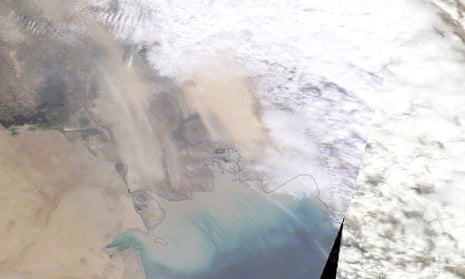A suffocating dust storm sweeping across western Iran has disrupted life in an unprecedented fashion, closing down schools and government offices, bringing flights to a standstill and provoking protests.
A large group of people in the western city of Ahwaz, the capital of Iran’s oil-rich Khuzestan province, gathered in protest at the government’s handling of the environmental crisis on Tuesday. Protesters demanded the administration of President Hassan Rouhani to act, holding up placards saying that “healthy air is our right”.
#گزارشتصویری #اهواز #خوزستان http://t.co/MrGTh8lAi5 pic.twitter.com/1YceusT1T5
— madyar (@madyar) February 10, 2015
Many others took to social networking websites such as Twitter and Facebook, sharing harrowing pictures of how ordinary citizens are grappling with an enormous amount of dust and sand in the air, which are reported to be tens of times above the healthy limit.
“We are breathing dust here, not oxygen,” said one Twitter user. “It is really, really terrifying,” said another. As well as Khuzestan, the dust storm has also hit other western Iranian provinces, such as Ilam, Lorestan, Kurdistan and Kermanshah.
RT @amirrmte: #اهواز #KhuzestanCantBreath pic.twitter.com/qtJbanYZ7q
— Mehdi Heydarian مهدی (@MehdiHeydarian) February 8, 2015
In Khuzestan many are using #KhouzestanCantBreathe on Twitter to bring their problem to the nation’s attention. Others wrote messages on car bonnets and other surfaces covered with dust and posted them online.
#Ahvaz: #Khuzestan struck by dust storm, #pollution #environment pic.twitter.com/02p0OhEfwu
— Tavaana (@Tavaana) February 10, 2015
Shahriar Askari, an official with Khuzestan’s environmental protection organisation, told the state Irna news agency that the amount of dust in the air on Tuesday was 66 times above the healthy level. Citizens are advised to stay indoors or wear face masks when going outside.
A combination of drought, shrinking wetlands and overall environmental deterioration in neighbouring Iraq and Saudi Arabia are blamed for the situation in western Iran.
سلام #اهواز به آقای #روحانی @Rouhani_ir @HassanRouhani #خوزستان #گردوغبار pic.twitter.com/ek4merA1Ic
— Sadraa Mohaqeq (@SadraMohaqeq) February 8, 2015
گرد و غبار و غلظت #ریزگرد ها، 10 شهر #خوزستان، از جمله #اهواز را به تعطیلی کشاند: ایرنا pic.twitter.com/BYwrnCwbQV
— Sattar Saeedi (@SattarSaeedi) February 10, 2015

Comments (…)
Sign in or create your Guardian account to join the discussion